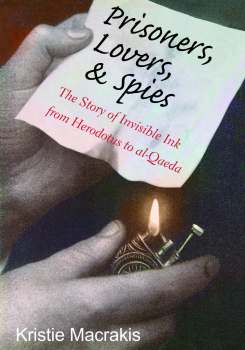A Recipe For Invisible Ink
An excerpt from “Prisoners, Lovers & Spies: The Story of Invisible Ink from Herodotus to al-Qaeda.”
The following is an except from Prisoners, Lovers & Spies: The Story of Invisible Ink from Herodotus to al-Qaeda, by Kristie Macrakis,
One of my favorite invisible-ink stories, that didn’t make the book, is about a Thomas Robins, imprisoned in Britain’s Wandsworth Prison, who developed invisible ink from oatmeal, or porridge, as it is called in Britain, in 1935. He squeezed a portion of porridge “through a piece of rag” and then used the liquid with an ordinary pen nib. Even though he didn’t try to use it to escape from prison, he presented it to His Majesty’s Principal Secretary of State for the Home Office in an effort to win an early release. Robins thought that if “this knowledge were to become public prison property, it would be of stupendous benefit to “Englands [sic ] underworld.”
In Britain, “Doin’ porridge” is a common euphemism for serving a prison sentence. Who knew that the porridge served for breakfast at His Majesty’s pleasure in the 1930s could in fact be used as secret (although quite stodgy) writing ink? Since prisoners got porridge without milk every day for breakfast, it was an easy substance to find. A simple tincture of iodine dropped on the message developed it into a beautiful blue color. When British specialists from MI5 and the Metropolitan Police experimented with this ink, they noted that it did not appear with a quartz ultraviolet lamp when used with water. It was a novel method for them. As long as no chunks made it onto the page, the prison guards would not detect it. If milk was added, though, detection was easier. As a result, MI5 and the police recommended adding milk to prisoners’ porridge as a preventative. Robins was not given an early release.
It’s the starch in the porridge that picks up the iodine and makes a blue-black-colored complex. Starch and iodine are extremely sensitive mutual indicators. Starch molecules look similar to long coiled springs; the deep blue color of the starch-iodine complex is thought to be due to iodine molecules fitting into the spaces between those coils.

We used the following recipe to make a starch ink in our kitchen:
Heat 2 cups of water to boiling in a small saucepan. Mix 2 heaping teaspoons of a starch (like oatmeal) in 1/3 shot glass of cold water, and stir to make a slurry.
Once the water in the saucepan is boiling, carefully add the white starch slurry, stirring and continuing to boil for two minutes to make a good solution. The starch solution will thicken as it cools. A message can be written with a fine paintbrush or a Q-tip. For a finer line, snip one end from the Q-tip and use the cut end.
Once dried, the writing is developed with a dilute iodine solution. Always wear gloves and glasses to protect skin and eyes. Simply brush medicinal iodine tincture (or povidone) on the paper or apply it with an eye dropper. The paper will also pick up iodine initially—but without the starch, most of the iodine will leave the paper within a few hours, really contrasting the blue starch writing.
Excerpted from Prisoners, Lovers & Spies: The Story of Invisible Ink from Herodotus to al-Qaeda, by Kristie Macrakis, published March 2014 by Yale University Pres. Copyright ©2014 by Kristie Macrakis. Reprinted by permission of Yale University Press.
Kristie Macrakis is author of Prisoners, Lovers, & Spies: The Story of Invisible Ink from Herodotus to al-Qaeda (Yale, 2014) and professor of history, technology, and society at Georgia Tech in Atlanta, Georgia.